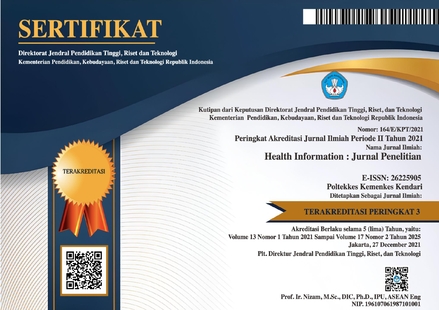Identification of Pathogenic Fungi in Gas Station Toilet Tub in Rumbai District, Pekanbaru City
DOI:
https://doi.org/10.36990/hijp.v11i2.128Keywords:
Air bak, Jamur pathgen, Toilet SPBUAbstract
Water is a source of disease transmission. Many water-borne diseases are caused by contamination by bacteria, viruses, parasites and fungi. Fungal contamination of water comes from water sources that are not properly maintained. Lacto Phenol Cotton Blue (LPCB) solution serves to color the mushrooms blue. The purpose of this study was to determine the pathogenic fungi found in the water of gas stations in Rumbai District, Pekanbaru City. This research was conducted using experimental methods in the laboratory. Laboratory tests include planting on PDA (Potato Dextrose Agar) media using the pour plate method. The identification was carried out macroscopically by looking at the shape and color of the colony, and microscopically using the LPCB solution. The results obtained from this study were mostly found Candida fungi and there are also other fungi such as Aspergillus, Trichophyton, Penicillium. From the results obtained, it was concluded that in the toilet water of gas stations in Rumbai District, Pekanbaru City, found pathogenic fungi.
References
De Toni, P. S.-A., & Reilly, K. (2011). A REVIEW OF FUNGI IN DRINKING WATER AND THE IMPLICATIONS FOR HUMAN HEALTH.
Ezikanyi, D. N., Nnamani, C. V., & Inyang, U. J. Assessment of Airborne Fungi in an Indoors Laboratory Toilet.
Hasanah, U. 2017. Mengenal Aspergillosis, Infeksi Jamur Genus Aspergillus. Jurnal Keluarga Sehat Sejahtera, 15(30), 76–86.
Indrawati, I., dan Fakhrudin, S. D. 2016. Isolasi dan Identifikasi Jamur Patogen pada Air Sumur dan Air Sungai di Pemukiman Warga Desa Karangwangi, Cianjur, Jawa Barat. Jurnal Biodjati, 1(1), 27–38.
IKAPI. 2015. Pemeriksaan Mikrobiologi pada Penyakit Infeksi. Sagung Seto. Surabaya.
Irianto, K. 2013. Parasitologi Medis. Alfabeta. Bandung.
Jawets, A.,mMelnick, J., dan adelberg, A. 1995. Mikrobiologi Kedokteran. EGC Jakarta.
Jawets, A.,mMelnick, J., dan adelberg, A. 2004. Mikrobiologi Kedokteran. EGC Jakarta.
Jawets, A.,mMelnick, J., dan adelberg, A. 2006. Mikrobiologi Kedokteran. EGC Jakarta.
Jawets, A.,mMelnick, J., dan adelberg, A. 2010. Mikrobiologi Kedokteran. EGC Jakarta.
Novak Babi?, M., Gunde-Cimerman, N., Vargha, M., Tischner, Z., Magyar, D., Veríssimo, C., . . . Brandão, J. (2017). Fungal Contaminants in Drinking Water Regulation? A Tale of Ecology, Exposure, Purification and Clinical Relevance. International journal of environmental research and public health, 14(6), 636. doi:10.3390/ijerph14060636.
Notoatmodjo, S. 2010. Metodologi Penelitian Kesehatan. RINEKA CIPTA.Jakarta.
Pedro-Botet, M. L., Sanchez, I., Sabria, M., Sopena, N., Mateu, L., García-Núñez, M., & Joly, C. R. (2007). Impact of copper and silver ionization on fungal colonization of the water supply in health care centers: implications for immunocompromised patients. Clinical infectious diseases, 45(1), 84-86.
Prahatamaputra, A. 2009. Karakteristik Jamur Candida albicans Berbasis Fermentasi Karbohidrat Pada Air Bak WC Sekolah Menengah di Kelurahan Alalak Utara. Jurnal Wahana-Bio, 2(2).
Qurrohman, M. T., dan Nugroho, R. W. 2015. Pengaruh Frekuensi Menguras Terhadap Jumlah Candida sp. Pada Air Bak Toilet Wanita di SPBU Surakarta. Biogenesis, 3(1).
Soedarto. 2015. Mikrobiologi Kedokteran. Sagung Seto. Surabaya.
Sinaga, A. Y. (2014). Sanitasi dan Pemantauan Jentik Nyamuk pada Toilet Sekolah Dasar di Desa Sei Rotan Kecamatan Percut Sei Tuan Kabupaten Deli Serdang Tahun 2013. Lingkungan Dan Keselamatan Kerja, 3(2).
Subandi. 2014. Mikrobiologi. PT Remaja Rosdakarya. Bandung.
Suriaman, E., dan Apriliasari, W. P. 2017. Uji Mpn Coliform dan Identifikasi Fungi Patogen pada Air Kolam Renang di Kota Malang. Jurnal SainHealth, 1(1), 15–22.
Short, D. P., O'Donnell, K., Zhang, N., Juba, J. H., & Geiser, D. M. (2011). Widespread occurrence of diverse human pathogenic types of the fungus Fusarium detected in plumbing drains. Journal of Clinical Microbiology, 49(12), 4264-4272.
Zalar, P., Novak, M., De Hoog, G., & Gunde-Cimerman, N. (2011). Dishwashers–a man-made ecological niche accommodating human opportunistic fungal pathogens. Fungal biology, 115(10), 997-1007.
Zhang, E., Tanaka, T., Tajima, M., Tsuboi, R., Nishikawa, A., & Sugita, T. (2011). Characterization of the skin fungal microbiota in patients with atopic dermatitis and in healthy subjects. Microbiology and immunology, 55(9), 625-632.
Zupan?i?, J., Babi?, M. N., Zalar, P., & Gunde-Cimerman, N. (2016). The black yeast Exophiala dermatitidis and other selected opportunistic human fungal pathogens spread from dishwashers to kitchens. PLoS ONE, 11(2).
Downloads
Published
How to Cite
Issue
Section
Citation Check
License
Copyright (c) 2019 Mega Pratiwi Irawan, Siti Juariah, Syarifah Rukmaini

This work is licensed under a Creative Commons Attribution-ShareAlike 4.0 International License.
Authors retain copyright and grant the journal right of first publication with the work simultaneously licensed under a Creative Commons Attribution-ShareAlike 4.0 International License that allows others to share the work with an acknowledgment of the works authorship and initial publication in this journal and able to enter into separate, additional contractual arrangements for the non-exclusive distribution of the journals published version of the work (e.g., post it to an institutional repository or publish it in a book).















